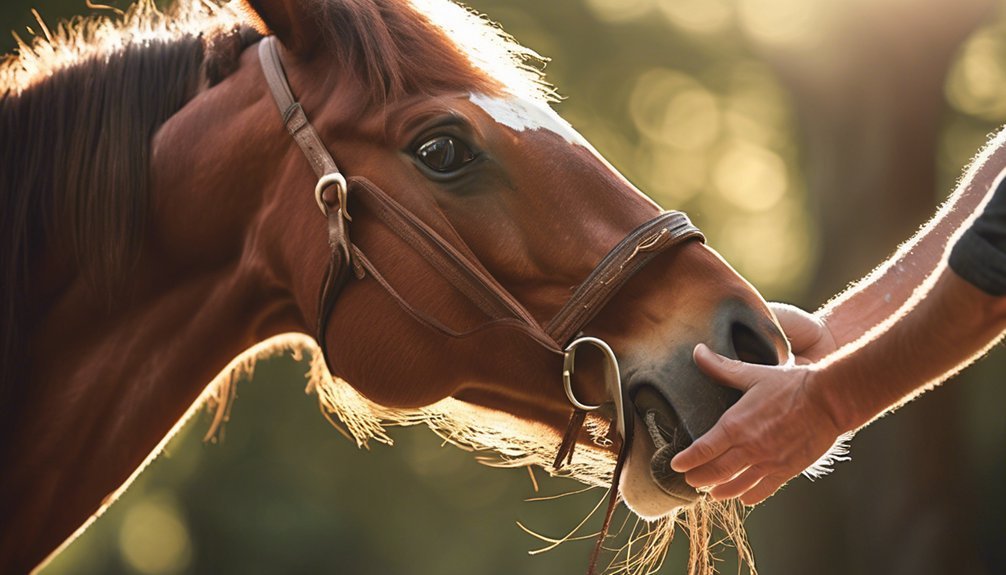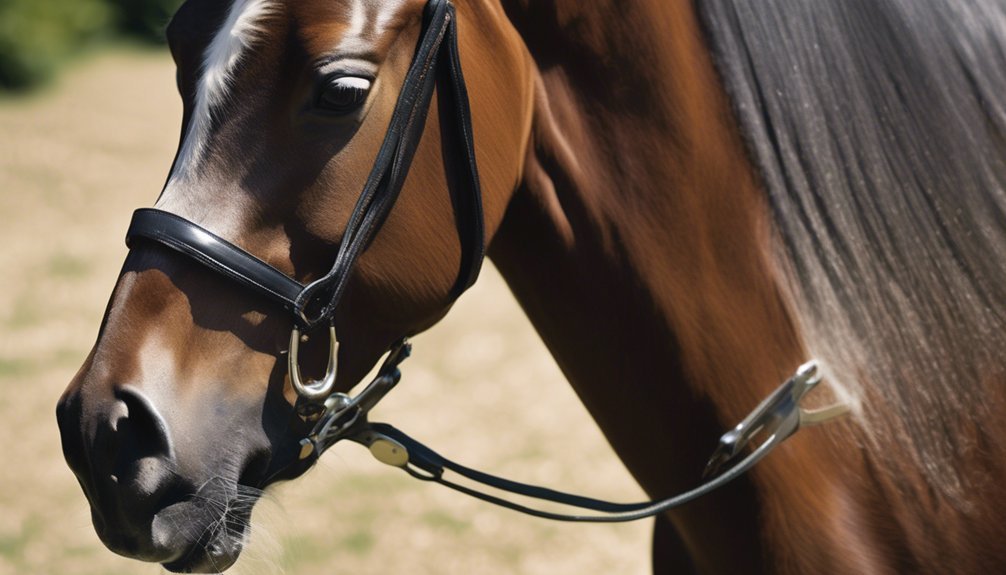
Grooming your horse isn't just about keeping their coat clean; it's a vital opportunity to build trust and strengthen your bond. As you approach each session, consider your horse's body language and emotions. Establishing a routine can make them feel secure, but there's more to it than just brushing. Understanding how to interpret their responses and using the right techniques can lead to a deeper connection. What steps can you take to ensure your horse feels safe and comfortable?
Key Takeaways
- Approach your horse gently and create a calming atmosphere to foster initial trust.
- Use grooming tools suited to your horse's sensitivities to enhance comfort during sessions.
- Establish a consistent grooming routine to provide predictability and reassurance for your horse.
- Incorporate positive reinforcement, such as treats and praise, to encourage calm behavior during grooming.
- Pay attention to your horse's body language, adjusting your approach to build a deeper connection.
Understanding Your Horse's Body Language

Understanding your horse's body language is essential for building a strong bond and ensuring a positive grooming experience. As you watch your horse, pay attention to subtle body signals; they often reveal their emotions.
A relaxed posture, soft eyes, and gentle nuzzling indicate comfort and trust. Conversely, pinned ears, a swishing tail, or a tense stance may suggest anxiety or irritation.
When you recognize these horse emotions, you can adjust your approach, creating a more harmonious interaction. Take your time, listen to their cues, and engage with patience.
This attentiveness not only enhances the grooming process but deepens your connection, allowing both you and your horse to feel understood and valued. Trust grows when you truly comprehend their unspoken language.
Choosing the Right Grooming Tools
Selecting the right grooming tools can make a world of difference in your horse's grooming experience. Each grooming tool type serves a specific purpose, whether it's a curry comb for loosening dirt or a soft brush for a gentle finish.
Pay attention to your horse's sensitivities; the right tools can enhance their comfort and trust in you. Regular tool maintenance is essential, too—cleaning brushes and checking for wear ensures you're providing the best care possible.
Invest in high-quality tools that feel good in your hands, as this connection translates to your horse. Remember, your choices reflect your commitment to their well-being, making those grooming sessions not just routine but a cherished bonding experience.
Establishing a Routine for Grooming Sessions

Creating a consistent grooming routine not only enhances your horse's physical appearance but also strengthens the bond between you two.
By establishing a grooming schedule with consistent timing, you help your horse feel secure and valued. Choose a time that works for both of you, whether it's early mornings or late afternoons, and stick to it. This predictability reassures your horse, making them more responsive to your touch.
During these sessions, be present and attentive, noticing any changes in their coat or demeanor. Use this time not just for grooming, but for connection; talk softly, offer treats, and cherish these moments.
Over time, you'll both come to look forward to this special time together, deepening your relationship.
Starting Slow: Building Comfort and Trust
As you begin your grooming sessions, it's essential to start slow and let your horse adjust to your presence and touch. Your initial interactions set the tone for trust.
Approach gently, speaking softly to create a calming atmosphere. Use gradual exposure to familiarize your horse with your movements, allowing them to feel safe.
Spend those first moments simply standing close, letting them sniff you or nuzzle your hand. Gradually introduce the grooming tools, ensuring your horse is comfortable before you start brushing.
Pay attention to their body language; if they flinch or pull away, pause and reassure them.
Focusing on Sensitive Areas During Grooming

Once your horse feels comfortable with your presence, it's time to pay special attention to sensitive areas during grooming.
These spots can hold tension or discomfort, so using gentle grooming techniques is essential for building trust. Approach these areas with care and observation, noticing how your horse responds.
- Face: Use soft brushes or your hands to gently stroke around the muzzle and eyes.
- Ears: Be cautious; lightly rub the base of the ears to provide comfort.
- Belly: Many horses are sensitive here; start with gentle strokes, moving gradually.
- Legs: Use a light touch to avoid startling your horse, especially around joints.
Using Grooming as a Time for Bonding
Grooming your horse isn't just about keeping their coat clean; it's a wonderful opportunity to strengthen your bond. As you brush away dirt and debris, notice how your horse relaxes under your touch.
This shared time fosters trust building, allowing your horse to feel safe and secure in your presence. The grooming benefits extend beyond a shiny coat; it deepens your connection, making your horse more receptive to your cues.
As you spend those quiet moments together, pay attention to their reactions. You'll learn what they enjoy and what makes them anxious.
This intimacy transforms grooming into a ritual of love and care, enhancing your relationship and nurturing a profound understanding that enriches both your lives.
Incorporating Positive Reinforcement

Three simple steps can transform grooming into a positive experience for both you and your horse. By incorporating positive reinforcement strategies, you'll foster trust and connection.
Here's how to do it:
- Use Treats: Offer small, healthy treats when your horse remains calm during grooming.
- Praise: Verbally praise your horse for standing still or allowing you to brush sensitive areas.
- Short Sessions: Keep grooming sessions brief at first, gradually increasing duration as your horse adapts.
- Consistency: Apply consistent behavior modification techniques to reinforce desired behaviors over time.
These approaches create a nurturing environment, making grooming a delightful bonding time.
Recognizing and Addressing Your Horse's Emotional Responses
Understanding your horse's emotional responses can significantly enhance your grooming experience. As you spend time together, pay attention to emotional signs like ear position, tail movement, and body posture. These subtle cues reveal your horse's feelings, helping you gauge their comfort level.
For instance, pinned ears or a tense body might indicate stress. If you notice these stress indicators, take a step back—allow your horse some space or try gentle, soothing strokes to ease their anxiety.
Being attuned to their emotional state fosters trust and deepens your bond. Remember, each grooming session is a chance to connect, so approach with empathy and patience, ensuring your horse feels safe and valued throughout the process.
Grooming Techniques for Different Coat Types

Recognizing your horse's emotional cues not only enriches your relationship but also sets the stage for effective grooming tailored to their unique coat type.
Each coat requires specific techniques to enhance grooming frequency and ensure proper coat care:
- Short Hair: Use a rubber curry comb to loosen dirt and debris, followed by a soft brush for a polished finish.
- Long Hair: Work with a wide-tooth comb to prevent tangles, then use a body brush to smooth and shine.
- Thick or Dense Coats: Employ a shedding blade during seasonal changes to manage loose hair effectively.
- Sensitive Skin: Opt for gentle, soft brushes and be mindful of pressure to avoid discomfort.
Making Grooming a Relaxing Experience for Your Horse
While you're grooming your horse, creating a calm and soothing environment can significantly enhance the experience for both of you. Use gentle grooming techniques to foster relaxation, and pay attention to your horse's body language. Soft strokes, rhythmic movements, and a quiet atmosphere will help your horse feel secure.
| Element | Description |
|---|---|
| Lighting | Soft, natural light |
| Sound | Gentle music or silence |
| Touch | Light, rhythmic brushing |
| Environment | Clean, familiar space |
| Scent | Calming essential oils (lavender) |
Frequently Asked Questions
How Often Should I Groom My Horse?
You should groom your horse at least a few times a week. Regular grooming not only keeps their coat healthy but also strengthens your bond, enhancing trust and communication between you both. It's a beautiful connection.
Can Grooming Help With My Horse's Anxiety?
Grooming your horse's coat is like soothing a feathered blanket, wrapping them in calm. By using gentle grooming techniques, you can promote anxiety reduction, helping your horse feel secure and connected to you during each session.
What if My Horse Dislikes Certain Grooming Tools?
If your horse dislikes certain grooming tools, observe their reactions closely. You might explore grooming alternatives, like softer brushes or your hands, to ease tool sensitivity and create a more comfortable, trusting grooming experience for both of you.
Should I Groom My Horse After Riding?
After riding, picture your horse's coat glistening in the sun. Grooming not only removes sweat and dirt but strengthens your bond. Establishing a soothing post-ride grooming routine enhances trust, making every ride more enjoyable.
How Can I Tell if My Horse Enjoys Grooming?
To tell if your horse enjoys grooming, watch for body language cues like relaxed ears, lowered head, and soft eyes. Notice their grooming preferences too; some love a good scratch while others prefer gentle brushing.
Conclusion
Incorporating grooming into your routine is like nurturing a fragile plant; with patience and care, it'll flourish. By understanding your horse's body language and responding to their needs, you create a safe space that fosters trust. Over time, as you both grow comfortable with each other, these sessions can transform into bonding moments filled with affection and understanding. Remember, it's the gentle touches and consistent presence that solidify your connection, making every grooming experience a step toward a deeper relationship.





